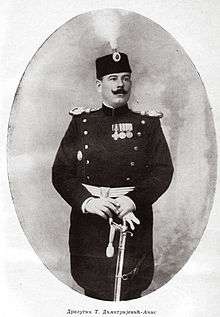Dragutin Dimitrijević
| Dragutin Dimitrijević | |
|---|---|
 Dimitrijević, circa 1900 | |
| Born |
17 August 1876 Belgrade, Principality of Serbia |
| Died |
24 June 1917 (aged 40) Thessaloniki, Kingdom of Greece |
| Cause of death | Execution by firing squad |
| Nationality | Serbian |
Dragutin Dimitrijević (Serbian Cyrillic: Драгутин Димитријевић; 17 August 1876 – 24 June 1917), known as Apis (Апис), was a Serbian colonel. He was a leading member of a military group that organized the overthrow of the Serbian government in 1903. He personally organized and participated in the coup against King Alexander and his wife Queen Draga that resulted in their murders, though he was not present when they were killed.[1] He was also the leader of the Black Hand group responsible for the assassination of Franz Ferdinand, Archduke of Austria in June 1914. The latter triggered the July Crisis which led to the outbreak of World War I.
Early life
Dragutin Dimitrijević was born in Belgrade, Principality of Serbia in the summer of 1876. Dimitrijević entered the Belgrade Military Academy at age sixteen. A brilliant student, Dimitrijević was recruited into the General Staff of the Serbian Army immediately after his graduation.
May Overthrow
Captain Dimitrijević and a group of junior officers planned the assassination of the king of Serbia. On 11 June 1903, the group stormed the royal palace and killed both King Alexander and his wife Queen Draga. During the attack Dimitrijević was badly wounded, and, although he eventually recovered, the three bullets from the encounter were never removed from his body.
The Serbian parliament described Dimitrijević as "the saviour of the fatherland" and he was appointed Professor of Tactics at the Military Academy. He visited Germany and Russia where he studied the latest military ideas. During the Balkan Wars that took place in 1912 and 1913, Dimitrijević's military planning helped the Serbian Army achieve several important victories.

Dimitrijević's main concern was what he viewed as the liberation of all South Slavs, especially Serbs, from Austria-Hungary. Although Serbia was already an independent country, many Serbs in Bosnia and Herzegovina, Croatia and Vojvodina were still under Austro-Hungarian rule. Dimitrijević, who used the code name Apis, became leader of the secret Black Hand group. Dimitrijević with his men disguised as Albanians while committing political murders. [2]
Sarajevo assassination
In 1911, Dimitrijević organised an attempt to assassinate the octogenarian Austrian Emperor Franz Josef. When this failed, Dimitrijević turned his attention to the heir to the throne, Archduke Franz Ferdinand. Dimitrijević was concerned about Ferdinand's plans to grant concessions to the South Slavs, fearing that, if this happened, a unified Serbian state would be more difficult to achieve.
When Dimitrijević heard that Archduke Franz Ferdinand was planning to visit Sarajevo in June 1914, he sent three members of the Young Bosnia group, Gavrilo Princip, Nedeljko Čabrinović, Trifko Grabež and four others from Serbia to assassinate him. At this time, Dimitrijević was Chief of Serbian Military Intelligence.
Unknown to Dimitrijević, Major Vojislav Tankosić was informing Nikola Pašić, the prime minister of Serbia about the plot. Although Pašić supported the main objectives of the Black Hand group, he did not want the assassination to take place, as he feared it would lead to a war with Austria-Hungary. He therefore gave instructions for the three young would-be-assassins to be arrested when they attempted to leave the country. However, his orders were not implemented, and the three men arrived in what was then known as the Condominium of Bosnia and Herzegovina, where they joined forces with fellow conspirators, Veljko and Vaso Čubrilović, Muhamed Mehmedbašić, Danilo Ilić, Cvjetko Popović and Miško Jovanović.
After the assassination of Archduke Franz Ferdinand of Austria on 28 June 1914, several Black Hand members, under interrogation by the Austrian authorities, claimed that three men from Serbia (Dimitrijević, Milan Ciganović, and Major Voja Tankosić) had organised the plot.
On 23 July 1914, the Austro-Hungarian government sent its July Ultimatum to the Serbian government with a lengthy list of ten different demands. In his response on 25 July 1914, Serbian prime minister Nikola Pašić, accepted all the points of the ultimatum except point #6, demanding Serbia to allow an Austrian delegation to participate in a criminal investigation against those participants in the conspiracy that were present in Serbia. Three days later the Austro-Hungarian Empire declared war on Serbia.
In 1916, Dimitrijević was promoted to colonel.[3]
Execution
Nikola Pašić decided to get rid of the most prominent members of the Black Hand movement, by then officially disbanded. Dimitrijević and several of his military colleagues were arrested in December 1916, and tried on charges blaming them with attempted assassination of regent Aleksandar I Karađorđević in September 1916. On 23 May 1917, following the Salonika Trial, Dimitrijević was found guilty of treason and sentenced to death. A month later, on 24 June 1917, he was executed by firing squad.
In 1953, Dimitrijević and his co-defendants were all posthumously retried by the Supreme Court of Serbia and found not guilty, because there was no proof for their alleged participation in the assassination plot.[4]
References
- ↑ MacKenzie 1989.
- ↑ Pearson 2005, pp. 27-28 and 585.
- ↑ http://www.britannica.com/EBchecked/topic/163729/Dragutin-Dimitrijevic
- ↑ MacKenzie 1998, p. 290.
Bibliography
- MacKenzie, David (1989). Apis: The Congenial Conspirator. The Life of Colonel Dragutin T. Dimitrijevic. New York: Columbia University Press. ISBN 0-88033-162-3.
- MacKenzie, David (1998). The Exoneration of the "Black Hand". Boulder, CA: East European Monographs. ISBN 0-88033-414-2.
- Pearson, Owen (2005). Albania in the Twentieth Century, A History: Volume I: Albania and King Zog, 1908-39. I.B.Tauris. ISBN 9781845110130.
- Pikul, Valentin. To Have Honor. The main character of this book was friends with Apis and helped in the murder of Aleksandar Obrenović and his wife in 1903.
- Živanović, Milan (1955). Solunski proces 1917. Beograd: Savremena administracija.
External links
- Dragutin Dimitrijević Apis - Dokumentarni film on YouTube (Serbian)